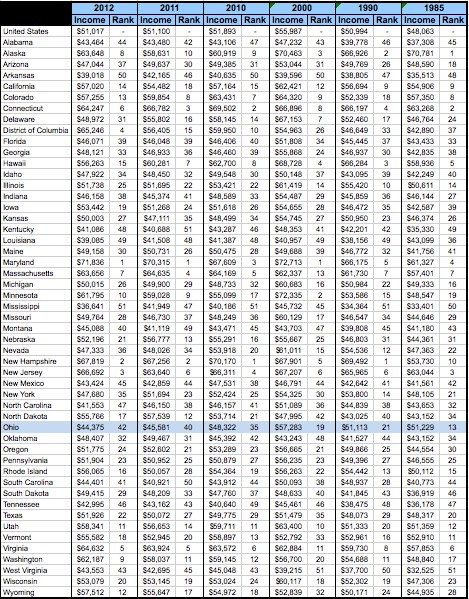By Mary McCleary
With the downturn in Ohio’s economy, families have lost and are still losing ground, in spite of our pallid recovery. Instead of experiencing growing incomes that allow them to get ahead and further provide for their kids, parents are bringing less to the table and are no doubt working just as hard to do so.
According to the recently released 2012 U.S. Census Bureau data, Ohioans are worse off than they were in 2011. In inflation-adjusted dollars, Ohio’s median household income dropped over $1,200 to $44,375. In fact, after adjusting for inflation, Ohio’s median household income is the lowest it has ever been between 1984 (the first year that data is available) and 2012. Since 2007, the income of the median Ohio family has dropped about $10,000.[1]
Ohio’s median household income in 2012 was $6,642 below the national median, which was $51,017. Among the states, Ohio currently ranks 10th worst. Ohio’s neighbors Michigan and Indiana, both now right-to-work states, are ahead of Ohio. In 2011, Indiana’s household income was about $200 less than Ohio’s. With right-to-work laws passed at the beginning of 2012, Indiana’s median household income is now about $1,200 greater than Ohio’s.[2]
Historically, Ohio has regularly been in the top half of states for household income and above the national median. As recently as 2000, Ohio’s income was 19th best among the states. In just 12 years, it has fallen 22 spots. Most of the nine states behind Ohio are in the Deep South and West Virginia, which historically have had incomes below the national average.[3] In 1985, Ohio was 13th best (see appendix).
With the expiration of the Bush tax cuts at the beginning of this year and the new Obamacare payroll tax hike, Ohioans lost even more financial resources for their families.
Even though Ohio’s economy has started growing again after shedding over 600,000 jobs between 2000 and 2010, Ohio is a laggard even in its recovery. From January 2012 to June 2013, Ohio experienced the 11th worst private-sector job growth in the nation. Over the 18-month period, Ohio added jobs at an annual growth rate of one percent. If the August preliminary jobs numbers hold, Ohio will have only added about 20,000 in 2013 thus far, putting the state on pace to add just 30,000 jobs this entire year – a growth rate of 0.68 percent annually.
It is no wonder that Ohio would be losing population if our births did not exceed deaths.[4] It is also not a surprise that Ohio’s families are fleeing to economically prosperous states – the top three being Florida, Texas, and North Carolina, all of which are right-to-work states.[5] In line with that problem is Ohio’s brain drain. Many of our best and brightest students move out of the state after college to pursue better opportunities. Though in recent years the bleeding has subsided, from 1990 to 2010, Ohio’s young adult population decreased by 420,000 people.[6] For those who want to get ahead, Ohio simply is not the state of choice.
For those still in Ohio, more and more people are adding themselves to the rolls of government assistance. As the Columbus Dispatch highlighted in April, the number of food stamp recipients nationwide has increased 70 percent since 2008.[7] Equally problematic is that nearly one in six Ohioans is on food stamps.[8]
Along with the rise in welfare recipients, many states, including Ohio, are experiencing increases in disability claims. For every three people on disability, one has a mental disorder.[9] Some have charged that disability is the new welfare for those who can’t find their place in the work force.
Though Ohio has added jobs in the last few years, Ohio’s work force continues to shrink as discouraged workers either quit looking for work or move out of state. Since December 2012, Ohio’s unemployment rate jumped from 6.7 percent to 7.3 percent. Even still, this number fails to take into account those who have left the workforce. Based on this data, Opportunity Ohio estimates that Ohio’s real unemployment rate is really above 9 percent. This number does not include those who are underemployed.
Additionally, Ohio’s labor force has declined severely since 2007 and is now slightly less than it was in 1999. While participation in the labor force has declined, the working age population has increased steadily. Ohio’s labor force participation rate currently ranks 31st among the states, down from 23rd in 2008.[10]
While we all like to hear good news, reality is that Ohio’s families are still struggling. From declining incomes and fewer opportunities to long-term unemployment, underemployment, and food stamps, Ohioans are still feeling the pain of the recession.
Though the income data and jobs data are new, the story is not, and Ohioans have had enough. It is time for our leaders to realize that their policies are not working. Until our elected officials wake up to this reality, Main Street Ohio and the families that depend its success will struggle.
Most Ohioans have had to make do with less; however, government spending continues to grow exponentially at a rate that far exceeds inflation. As Matt A. Mayer stated in his July state budget analysis, “From Governor Kasich’s first year to his fourth year, Ohio’s budget has grown by 20.1% or 6.7% each year; [t]he budgetary growth under Governor Kasich is the largest increase during a gubernatorial term since 1991.”[11] Excessive government spending places an unnecessary burden on working Ohioans and is projected to lead to deficits in the future.
Instead of expanding costly government programs such as Medicaid, the Governor should consider instituting real reforms that will give people a hand up instead of another hand out. One such reform that would go a long way in turning things around is the implementation of right-to-work laws. Since Ohio is a forced unionization state, companies have no incentive to open their doors here, especially when they can go next door to Indiana or Michigan. Since 1990, the average right-to-work state has grown 42 percent in terms of jobs, while the average forced unionization state has only grown 16 percent. In the last 23 years, Ohio’s jobs have only increased by 8 percent – half that of forced unionization state. Compared to all states, Ohio is ranked the fifth worst over the same time period.
Given the Governor’s current stance on right-to-work legislation, Ohio may have to wait until after 2018 for this important reform, unless passed by citizen initiative. Families cannot afford seemingly endless years of economic stagnation.
One recent bright spot in Ohio’s fight for economic competitiveness is the failure of the proposed severance tax hike, which was removed from the budget and appears to be dead. The Utica shale play is a boon to the poorest parts of Ohio and will provide a much-needed economic boost to landowners and businesses in the region. While cutting Ohio’s income tax is a noble goal, we must ensure it comes from a true reduction in government spending, not a redistribution of wealth or projected increases in future revenue.
The bottom line is that Ohioans are hurting, and we need big changes to get the state back on track. Solutions are not out of reach. However, it will take leadership and courage to right the ship. Ohio’s families, their futures, and ultimately the state’s future depend on it.
Appendix: Median Household Income Adjusted for Inflation (2012 Dollars)
[1] U.S. Census Bureau, “State Median Income, Median Household Income by State – Single-Year Estimates,” at http://www.census.gov/hhes/www/income/data/statemedian/ (September 18, 2013).
[2] Ibid.
[3] Ibid. For a detailed discussion on the historical position of southern states, see Chapter 8 in Matt A. Mayer’s book Taxpayers Don’t Stance a Chance.
[4] Ohio Development Agency Services, “Births, Death, and Natural Increase: Ohio 1950-2010,” at http://development.ohio.gov/files/research/P5018.pdf (September 18, 2013).
[5] Ohio Development Agency Services, “State Migratory Flows to and from Ohio: 1980-2010,” at http://development.ohio.gov/reports/reports_pop_est.htm (September 18, 2013).
[6] Associated Press, “Ohio May Be Stemming Brain Drain,” June 17, 2013, at https://www.toledoblade.com
/State/2013/06/17/Ohio-may-be-stemming-brain-drain.html (October 22, 2013).
[7] The Columbus Dispatch, “Editorial: Shine the Light on Food Stamps,” April 12, 2013, at http://www.dispatch.com/content/stories/editorials/2013/04/12/shine-light-on-food-stamps.html (September 18, 2013).
[8] Ohio Department of Jobs and Family Services, “Public Assistance Monthly Statistics Report,” June 2013, at http://jfs.ohio.gov/pams/Reports/PAMS2013-06.stm (September 18, 2013).
[9] Social Security Administration, “Annual Statistical Report on the Social Security Disability Insurance Program, 2011,” July 2012, at http://www.ssa.gov/policy/docs/statcomps/di_asr/2011/di_asr11.pdf (September 18, 2013).
[10] Opportunity Ohio, “Ohio’s Labor Force – Pictures of Decline,” August 2013, at https://www.opportunityohio.org/wp-content/uploads/2012/06/OPPOHIO-labor-force-201308.pdf (September 18, 2013).
[11] Matt A. Mayer, “When the Lines Cross: Failure to Make Tough Spending Choices Today Guarantees Deficits Tomorrow,” Opportunity Ohio, July 2, 2013, at https://www.opportunityohio.org/wp-content/uploads/2013/07/When-the-Lines-Cross.pdf (September 18, 2013).


